Weeds
Any plant that is growing where it is not wanted can be called a weed. Broadleaved weeds are very noticeable in a turf area because their appearance is much different than that of the grass. Their broader leaves ruin the uniformity and appearance that is expected in quality turf. Weeds also cause problems by competing with turf grass for sunlight, nutrients and moisture. Weeds can spread rapidly in turf by means of seeds, rhizomes, stolons and various underground storage organs such as bulbs and tubers.
Weed control implies chemical control to many people. However, best strategy is to prevent weed populations from appearing in the turf at all. This can be accomplished by correct establishment and management. Weeds become a problem when the grasses in your lawn either lose or do not achieve the correct density. Once this happens the weeds get a foothold and begin to flourish. If the grasses in your lawn are adaptable to the site and maintenance procedures are performed correctly, the grasses will thicken up enough to choke out most weed.
Lawn Weed Identification
- Creeping Buttercup [Ranunculus Repens]
Perennial spreading by seed and long branching stolons or runners which root at nodes along their length, forming new plants; one plant can spread over a 4m2 area in a year. The seed can remain in the soil for many years and germinate after cultivation. This is usually about 5 to 7 years. Viability reduces to about 50% after 20 years, but viable seed have been recovered after up to 80 years (it is easy to believe the latter figure!).
A problem in lawns is it forms a rosette with the growing point at soil level, so it resists mowing and can also tolerate a great deal of trampling. Plants buried during cultivation soon regrow from great depths and re-establish on the surface, but repeated disturbance in hot weather will reduce the numbers.
The buttercup is perennial weed with creeping stems that run along the ground rooting at intervals. Leaves are divided into three lobes that are toothed and hairy. Yellow flowers can be seen between May and August.
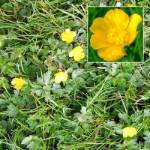
Buttercups prefer wet, heavy soil.
- Daisy [Bellis Perenis]
The daisy is a perennial weed very common in closely mown lawns and turf throughout the UK. It is a herbaceous plant with short creeping rhizomes and small rounded or spoon-shaped evergreen leaves 2–5 cm long, which grow close to ground. The flower heads are 2–3 cm in diameter, with white ray florets (often tipped red) and yellow disc florets. Although many people think that the flower had a yellow centre with white petals this is not the case. Each individual "petal" is itself an individual flower. In the centre there are many tiny yellow flowers also. The different colours and styles of flower work together in order to attract insects. This type of flower is known as a composite flower. They are produced on leafless stems 2–10 cm (rarely 15 cm) tall. The lawn daisy is a dicot.
Daisies flower from March to November. However they have been known to flower throughout the year if the weather conditions are mild during the winter months.

Daisies are common on all soil types and will tolerate close mowing.
- Dandelion [Taraxacum Officinale]
The dandelion is a perennial weed forming a large flat rosette with a tap root and are common on any grass dominated areas such as road side verges, fields as well as garden lawns. Typically 5 to 40 cm tall but sometimes up to 70 cm tall. The stems can be tinted purplish, they are upright or lax, and produce flower heads that are held as tall or taller than the foliage. The foliage is upright growing or horizontally orientated, with leaves having narrowly winged petioles or being un-winged.
The stems can be glabrous or are sparsely covered with short hairs. The 5–45 cm long and 1–10 cm wide leaves are oblanceolate, oblong, or obovate in shape with the bases gradually narrowing to the petiole. The leaf margins are typically shallowly lobed to deeply lobed and often lacerate or toothed with sharp or dull teeth.
The calyculi (the cup like bracts that hold the florets) are composed of 12 to 18 segments: each segment is reflexed and sometimes glaucous. The lanceolate shaped bracelets are in 2 series with the apices acuminate in shape. The 14 to 25 mm wide involucres are green to dark green or brownish green with the tips dark gray or purplish. The florets number 40 to over 100 per head, having corollas that are yellow or orange-yellow in colour. The fruits, which are called cypselae, range in colour from olive-green or olive-brown to straw-coloured to greyish, they are oblanceoloid in shape and 2 to 3 mm long with slender beaks. The fruits have 4 to 12 ribs that have sharp edges. The silky pappi, which form the parachutes, are white to silver-white in colour and around 6 mm wide. Plants have milky sap and the leaves are all basal, each flowering stem lacks bracts and has one single flower head. The yellow flower heads lack receptacle bracts and all the flowers, which are called florets, are ligulate and bisexual.
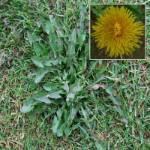
Dandelions bloom from Spring to Autumn and are common on all soil types.
- Greater Plantain [Plantago Major]
The greater plantain is a herbaceous perennial plant with a rosette of leaves 15-30 cm diameter. Each leaf is oval, 5-20 cm long and 4-9 cm broad, rarely up to 30 cm long and 17 cm broad, with an acute apex and a smooth margin; there are five to nine conspicuous veins. The flowers are small, greenish-grey with purple stamens, produced in a dense spike 5-15 cm long on top of a stem 13-15 cm tall (rarely to 70 cm tall).
The long green-grey flower heads are visible between May and September.
It grows better than most other plants in compacted soils, and is abundant beside paths, roadsides, and other areas with frequent soil compaction. It is also common in grasslands and as a weed in crops. It is wind-pollinated, and propagates primarily by seeds, which are held on the long, narrow spikes which rise well above the foliage.
The leaves are edible and used in herbal medicine, but can be somewhat tough. The taste is that of very bitter salad greens with a lingering aftertaste not unlike spinach. Younger leaves are recommended as they are more tender. The leaves when dried can be made into a tisane. The sinews from the broadleaf plantain are very pliable and tough when fresh and/or wettened, and can be used to make small cords or braiding.
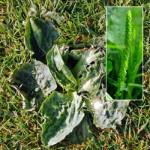
- Selfheal [Prunella Vulgaris]
A perennial which flowers from June to October. The clusters of purple flowers are held erect on square hairy stems and look similar to Bugle (Ajuga Repens). Established plants spread by creeping stems which root at intervals. The slightly hairy, oval leaves are borne in pairs and have a scalloped edge. It grows as a low clump which has a growing point below the sweep of mower blades, so is a problem in lawns.
As the common name suggests it has been used internally and externally as a medicinal herb to treat sores and wounds.
In grass it is controlled with Lawn Sand or individual weeds can be dug up. Large clumps are best treated with a selective weed killer containing dicamba or mecoprop and a number of applications at six-weekly intervals may be necessary. In other situations a systemic weed killer will work.
Selfheal is a common low growing perennial weed and a widespread problem in lawn and turf areas throughout the UK. Selfheal has creeping stems that root at intervals. Pairs of leaves are oval and hairy and have scalloped edges.
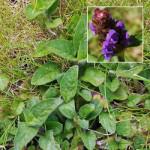
Selfheal produces clusters of purple flowers from June to September. Favours heavy, poorly drained soil.
- Ribwort Plantain [Plantago Lancelota]
Ribwort Plantain is a common perennial weed found on lawns in UK gardens. The plant is a rosette-forming perennial herb, with leafless, silky, hairy flower stems (10–40 cm/3.9–16 in). The basal leaves are lanceolate spreading or erect, scarcely-toothed with 3-5 strong parallel veins narrowed to short petiole. Grouping leaf stalk deeply furrowed, ending in an oblong inflorescence of many small flowers each with a pointed bract. Each flower can produce up to two seeds. Flowers 4 mm (calyx green, corolla brownish), 4 bent back lobes with brown midribs, long white stamens. Common throughout the country but scarce on acidic soils (pH < 4.5).
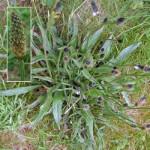
Flower heads are short on a long stalk, flowering between May and September.
- Common Yarrow [Achillea Millifolium]
Common Yarrow (also known as Milfoil) is an erect herbaceous perennial plant that produces one to several stems (0.2 to 1m tall) and has a rhizomatous growth form. Leaves are evenly distributed along the stem, with the leaves near the middle and bottom of the stem being the largest. The leaves have varying degrees of hairiness (pubescence). The leaves are 5–20 cm long, bipinnate or tripinnate, almost feathery, and arranged spirally on the stems. The leaves are cauline and more or less clasping. The inflorescence has 4 to 9 phyllaries and contains ray and disk flowers which are white to pink. There are generally 3 to 8 ray flowers that are ovate to round. Disk flowers range from 15 to 40. The inflorescence is produced in a flat-topped cluster. Yarrow grows up to 3500m above sea level. The plant commonly flowers from June through to August, and is a frequent component in butterfly gardens. Common yarrow is frequently found in the mildly disturbed soil of grasslands and open forests. Active growth occurs in the spring.
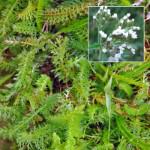
Yarrow will grow on all types of soil, including dry, infertile soils.
- White Clover [Trifolium Repens]
White Clover is a perennial weed very common in the UK. It has creeping runners that travel along the surface. Leaves are divided into three leaflets with a whitish band near the base of the leaf.
It is a herbaceous perennial plant. It is low growing, with heads of whitish flowers, often with a tinge of pink or cream that may come on with the aging of the plant. The heads are generally 1.5-2 cm wide, and are at the end of 7 cm peduncles or flower stalks. The leaves, which by themselves form the symbol known as shamrock, are trifoliolate, smooth, elliptic to egg-shaped and long-petioled. The stems function as stolons, so white clover often forms mats with the stems creeping as much as 18 cm a year, and rooting at the nodes.
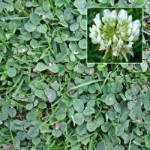
Flowers can be seen between May and October. It favours dry, non-acidic, nitrogen deficient soils and is very tolerant to close mowing.
